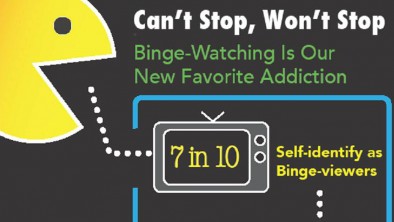Numerous subscription video-on-demand services already know it, and now a US-based survey conducted by New York’s Miner & Co. Studio, confirms it: Binge viewing is addictive.
This is potentially good news for those in the SVOD business – and the continuous flow of newcomers that skew towards kids – as two out of every five people surveyed were willing to pay more to instantly access full seasons of their favorite series instead of waiting for new episodes to air.
Titled Can’t Stop, Won’t Stop: Binge-Viewing Is our New Favorite Addiction, the study found that seven out of 10 US TV viewers consider themselves to be binge-viewers, an activity that the same percentage of respondents says is “addictive.”
The study identifies binge-viewing as watching three or more episodes of one series in a single sitting, with “frequent binge-viewers” being those who binge a few times per week or more and “infrequent binge-viewers” are those who binge once a month or less.
It shows that 17% of binge-viewers indulge in the activity on a daily basis, 63% weekly and 90% monthly. It also found that frequent binge-viewers skew younger (61% are Millennials) and more ethnically diverse (34% are non-white) than infrequent binge-viewers.
The study noted some unpleasant side effects to the habit, including:
Questionable hygiene – frequent binge-viewers are two-times more likely than infrequent binge-viewers to have skipped showering or bathing because they were binge-viewing.
Sluggishness – 27% of all viewers said binge-viewing made them feel sluggish or lazy.
Neglectfulness – Binge-viewing makes 18% of binge-viewers “pay less attention to other aspects of their lives,” with frequent binge-viewers nearly three-times more likely to order take-out instead of cooking for their family, or to skip a meal entirely, than infrequent binge-viewers, and more than twice as likely to oversleep the next morning;
Idleness – 30% dislike binge-viewing because it makes them less active.
Insatiable appetite – 43% of frequent binge-viewers watch more TV because of binge-viewing, yet 25% of all viewers surveyed said they dislike binge-viewing because they “don’t have anything left to watch once they finish.”
Among the study’s more surprising findings is the discovery that frequent binge-viewers are two-times more likely to let commercials play, and four-times more likely to upgrade their cable subscriptions than infrequent viewers.
Data for the Can’t Stop, Won’t Stop survey was gathered during March 2014 from 800 US TV viewers age 18 to 54 who have watch six-plus hours per week and have seen at least three episodes of a single show in one sitting at least once.
From StreamDaily
























